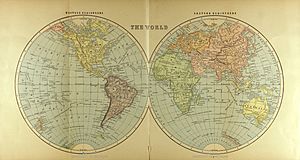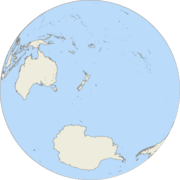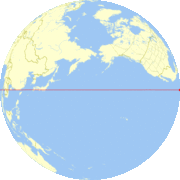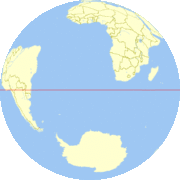Hemispheres of Earth facts for kids
Imagine cutting a round fruit like an orange exactly in half. That's kind of what a hemisphere is for Earth! In geography, a hemisphere is simply one half of our planet. We usually divide Earth into two main halves: the Northern Hemisphere and the Southern Hemisphere, split by the Equator. We also divide it into the Eastern Hemisphere and the Western Hemisphere, using an imaginary line called the prime meridian. Knowing about these halves helps us understand different parts of the world, their cultures, and their unique features.
Contents
Earth's Main Halves
Our planet is often divided into halves based on lines of latitude and longitude. These are like invisible lines on a map that help us locate places.
North and South Halves
These halves are separated by the Equator, an imaginary line that circles the middle of Earth.
- Northern Hemisphere: This is the half of Earth that is north of the Equator. It has most of the world's land, about 68% of it! About 90% of all people live here. Major land areas include North America, Europe, Asia, and most of Africa.
- Southern Hemisphere: This is the half of Earth that is south of the Equator. It has less land, about 32% of Earth's landmass. Only about 10% of the world's people live here. It includes South America, Australia, Antarctica, and the southern parts of Africa.
East and West Halves
These halves are separated by the prime meridian (0° longitude) and the 180th meridian (180° longitude).
- Eastern Hemisphere: This half is east of the prime meridian and west of the 180th meridian. It includes most of Africa, Europe, Asia, and Australia. It also covers the Indian Ocean and the western Pacific Ocean.
- Western Hemisphere: This half is west of the prime meridian and east of the 180th meridian. It includes North and South America, the eastern Pacific Ocean, the Caribbean Sea, and most of the Atlantic Ocean.
Other Ways to Divide Earth
Sometimes, Earth can be divided in other interesting ways. These divisions can show cultural differences or highlight certain features.
Cultural and Religious Halves
People sometimes talk about "Eastern" and "Western" hemispheres in terms of culture and religion.
- Eastern Hemisphere: This is often linked to cultures and religions that started in the East, like Buddhism, Hinduism, and Confucianism.
- Western Hemisphere: This is often linked to cultures and religions that started in the West, like Christianity, Judaism, and Islam.
Land and Water Halves
Scientists can also divide Earth to show where most of the land or water is.
- Land Hemisphere: This half has the most land possible. It's centered near Nantes, France. It includes most of the world's continents and large land areas.
- Water Hemisphere: This half has the most water possible. It's centered in the South Pacific Ocean. It includes most of the Indian, Atlantic, and Southern Oceans.
These different ways of dividing Earth help scientists and others understand our planet better. They can learn about where things are located, how cultures are spread, and what makes different parts of Earth special.
See also
 In Spanish: Hemisferio para niños
In Spanish: Hemisferio para niños
- Earth's geographical centre
- Global North and Global South
- Land and water hemispheres
- East–West dichotomy







